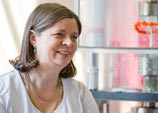Degradable bio-materials
Published:
With people living longer the demand is to keep them moving longer.
'With people living longer the demand is to keep them moving longer,' says Liz Tanner, Professor in Mechanics of Materials & Structures. Her past work has been instrumental in designing biomaterials to be used as permanent implants, such as hip and knee replacements. Recently however, her work has been focused on producing materials that can be naturally broken down and excreted by the body.
 'We're using polylactic acid and tri-calcium phosphate to form fibres. Using this technique we can get a material that is as stiff and strong as bone and will degrade naturally in the body, normally taking about 12-16 weeks. This gives us the sort of time that bone should take to repair itself.' Professor Tanner hopes that once perfected this technology could be used to fuse together damaged bones without leaving a permanent implant inside the patient.
'We're using polylactic acid and tri-calcium phosphate to form fibres. Using this technique we can get a material that is as stiff and strong as bone and will degrade naturally in the body, normally taking about 12-16 weeks. This gives us the sort of time that bone should take to repair itself.' Professor Tanner hopes that once perfected this technology could be used to fuse together damaged bones without leaving a permanent implant inside the patient.
Alongside her research into biodegradable bone materials, Professor Tanner has been influential in establishing the School of Engineering as a centre for interdisciplinary research. She has recently teamed up with Professor Duncan Gregory from the School of Chemistry to form the Glasgow Materials Research Initiative.
 'We're trying to get a forum for people throughout the University who are interested in material science so they can talk together to improve multidisciplinary projects. That involves chemists, engineers, physicists, Earth scientists, biologists, academics from the Dental School and in the longer run probably from the Medical and Vet Schools.'
'We're trying to get a forum for people throughout the University who are interested in material science so they can talk together to improve multidisciplinary projects. That involves chemists, engineers, physicists, Earth scientists, biologists, academics from the Dental School and in the longer run probably from the Medical and Vet Schools.'
Drawing students from such a range of backgrounds does present challenges, therefore Professor Tanner has designed a PhD lecture series that will complement the school's emphasis on multidisciplinary research. 'One of the problems being a young researcher in a multidisciplinary area is that you come with good background knowledge of your area but you don't know what other techniques are out there; you may need a wider range of other expertises to support your work,' she explains.
First published:
<< Features

